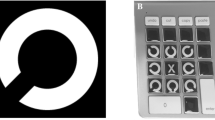Abstract
Objective
The aim of this study was to assess the functional head impulse test on migraine patients without vertigo. fHIT is a new vestibular test which evaluates the ability to see and read clearly during head movement as a functional measurement of the vestibulo-ocular reflex.
Materials and methods
The study included 20 patients suffering from migraine without vertigo between the ages of 20 and 30-years-old who were diagnosed by a neurologist and 20 individuals with non-migraine headaches (control group), with similar demographic characteristics. The functional head impulse test was applied to both groups, and the migraine disability assessment test was applied to migraine patients.
Results
There was no statistically significant difference in the general fHIT results between the migraine group and the control group (p > 0.05). However, a statistically significant decrease was obtained in migraine patients in the left lateral (p = 0.018) and right posterior (p = 0.029) semicircular canals at 4000 Hz and the right anterior semicircular canal at 6000 Hz (p = 0.019). When compared by the degree of migraine disability assessment test, no significant difference in the fHIT results were observed (p > 0.05).
Conclusion
The semicircular canals may be affected at high head acceleration (4000–6000 Hz) in migraine patients without a history of vertigo. It should be considered that fHIT results between 4000 and 6000 Hz in migraine patients without vertigo can be pathologic.





Similar content being viewed by others
Data availability
All data generated or analysed during this study are included in this published article.
Change history
05 May 2021
A Correction to this paper has been published: https://doi.org/10.1007/s00405-021-06852-z
References
Kang WS, Lee SH, Yang CJ, Ahn JH, Chung JW, Park HJ (2016) Vestibular function tests for vestibular migraine: clinical implication of video head impulse and caloric tests. Front Neurol 7:4–8. https://doi.org/10.3389/fneur.2016.00166
Lempert T, Olesen J, Furman J, Waterstond J, Seemungal B, Carey J, Bisdorff A, Versino M, Evers S, Newman-Toker D (2012) Vestibular migraine: diagnostic criteria. J Vestib Res 22(4):167–172. https://doi.org/10.3233/VES-2012-0453
von Brevern M, Lempert T (2016) Vestibular migraine. Handb Clin Neurol 137:301–316. https://doi.org/10.1016/B978-0-444-63437-5.00022-4
Lipton RB, Stewart WF, Diamond S, Diamond ML, Reed M (2001) Prevalence and burden of migraine in the united states: data from the american migraine study II. Headache 41(7):646–657. https://doi.org/10.1046/j.1526-4610.2001.041007646.x
Neuhauser HK, Von Brevern M, Radtke A, Lezius F, Feldmann M, Ziese T, Lempert T (2005) Epidemiology of vestibular vertigo: a neurotologic survey of the general population. Neurology 65(6):898–904. https://doi.org/10.1212/01.wnl.0000175987.59991.3d
Lee H, Sohn SI, Jung DK et al (2002) Migraine and isolated recurrent vertigo of unknown cause. Neurol Res 24(7):663–665
Cha YH, Lee H, Santell LS, Baloh RW (2009) Association of benign recurrent vertigo and migraine in 208 patients. Cephalalgia 29(5):550–555
Balci B, Naziye Ş, Gülden A (2018) Vestibüler Migren Hastalarında Dizabilite Seviyelerine Göre Denge ve Bilişsel İşlevlerin İncelenmesi. Neuropsychiatry 55:9–14. https://doi.org/10.29399/npa.12617
Sjögren J, Fransson P, Karlberg M, Magnusson M (2018) Functional head impulse testing might be useful for assessing vestibular compensation after unilateral vestibular loss. Front Neurol 9:1–7. https://doi.org/10.3389/fneur.2018.00979
Halmagyi GM, Curthoys IS (1988) A clinical sign of canal paresis. Arch Neurol 45:737–739. https://doi.org/10.1001/archneur.1988.00520310043015
Lee KJ (2003) Anatomy of the ear. In: Essential otolaryngology head and neck surgery. McGraw-Hill, pp 1–4
van Dooren TS, Lucieer FMP, Duijn S, Janssen AML, Guinand NP, Fornos A, Van Rompaey V, Kingma H, Ramat S, van de Berg R (2019) The functional head impulse test to assess oscillopsia in bilateral vestibulopathy. Front Neurol 10:1–6. https://doi.org/10.3389/fneur.2019.00365
Karli N, Ertas M, Baykan B, Uzunkaya O, Saip S, Zarifoglu M, Siva A (2007) The validation of ID migraineTM screener in neurology outpatient clinics in Turkey. J Headache Pain 8(4):217–223. https://doi.org/10.1007/s10194-007-0397-4
Corallo G, Versino M, Mandalà M, Colnaghi S, Ramat S (2018) The functional head impulse test: preliminary data. J Neurol 265(Suppl. 1):35–39. https://doi.org/10.1007/s00415-018-8910-
Ertaş M, Siva A, Dalkara T, Uzuner N, Dora B, Inan L, Idiman F, Sarica Y, Selçuki D, Şirin H, Oǧuzhanoǧlu A, Irkec C, Özmenoǧlu M, Özbenli T, Öztürk M, Saip S, Neyal M, Zarifoǧlu M (2004) Validity and reliability of the Turkish migraine disability assessment (MIDAS) questionnaire. Headache 44(8):786–793. https://doi.org/10.1111/j.1526-4610.2004.04146.x
Versino M, Mandalà M, Colnaghi S, Ricci G, Faralli M, Ramat S (2020) The integration of multisensory motion stimuli is impaired in vestibular migraine patients. J Neurol. https://doi.org/10.1007/s00415-020-09905-1
Boldingh MI, Ljøstad U, Mygland Å, Monstad P (2013) Comparison of interictal vestibular function in vestibular migraine vs migraine without vertigo. Headache 53(7):1123–1133. https://doi.org/10.1111/head.12129
Teixeira Maranhão E, Maranhão-Filho P, Raggio Luiz R, Borges Vincent M (2015) Migraine patients consistently show abnormal vestibular bedside tests Pacientes enxaquecosos consistentemente apresentam testes vestibulares de beira-de-leito anormais. Arq Neuropsiquiatr 74(1):22–28. https://doi.org/10.1590/0004-282X20150180
Yetiser S, Gokmen MHA (2015) Clinical aspects of benign paroxysmal positional vertigo associated with migraine. Int Tinnitus J 19(2):64–68. https://doi.org/10.5935/0946-5448.20150011
Funding
This research did not receive any specific grant from funding agencies in the public, commercial, or not-for-profit sectors.
Author information
Authors and Affiliations
Corresponding author
Ethics declarations
Conflict of interest
No conflict of interest.
Ethical approval
This study was approved by the Istanbul Aydin University Non-Interventional Clinical Research Ethics Committee (registration number 2019/118) on June 19th, 2019.
Consent to participate
Informed consent was obtained from all individual participants included in the study.
Consent for publication
The Authors declares that any person named as co-author of the contribution is aware of the fact and has agreed to being so named.
Additional information
Publisher's Note
Springer Nature remains neutral with regard to jurisdictional claims in published maps and institutional affiliations.
The original online version of this article was revised due to the figure 1 was published incorrectly and corrected in this version. In addition, this study was carried out between July-December 2019. It was mentioned incorrectly and corrected in this version.
Rights and permissions
About this article
Cite this article
Konukseven, Ö., Meral, M., Ekenel, D. et al. The clinical significance of fHIT in migraine patient without vertigo symptom. Eur Arch Otorhinolaryngol 279, 1721–1728 (2022). https://doi.org/10.1007/s00405-021-06811-8
Received:
Accepted:
Published:
Issue Date:
DOI: https://doi.org/10.1007/s00405-021-06811-8




